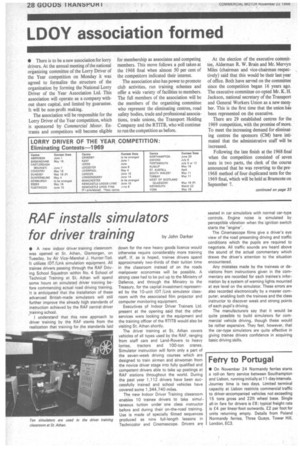RAF installs simulators
Page 30

If you've noticed an error in this article please click here to report it so we can fix it.
for driver training by John Darker • A new indoor driver training classroom was opened at St. Athan, Glamorgan, on Tuesday, by Air Vice-Marshal J. Hunter-Tod. It utilizes IDT/Link simulation equipment. All trainee drivers passing through the RAF Driving School Squadron within No. 4 School of Technical Training at St. Athan will spend some hours on simulated driver training before commencing actual road driving training. It is anticipated that the installation of these advanced British-made simulators will still further improve the already high standards of instruction achieved by the RAF central driver ,training school.
I understand that this new approach to driver training by the RAF stems from the realization that training for the standards laid down for the new heavy goods licence would otherwise require considerably more training staff. If, as is hoped, trainee drivers spend approximately two-thirds of their tuition time in the classroom instead of on the roads manpower economies will be possible. A strong case had to be put up to the Ministry of Defence, and through the Ministry to the Treasury, for the capital investment represented by the 10-unit IDTILink simulator classroom with the associated film projector and computer monitoring equipment.
Executives of Indoor Driver Trainers Ltd. present at the opening said that the other services were looking at the equipment and the training officer of the RTITB would also be visiting St. Athan shortly.
The driver training at St. Athan covers vehicles of all types used by the RAF, ranging from staff cars and Land-Rovers to heavy lorries, tractors and 100-ton cranes. Simulator instruction will form only a part of the seven-week driving courses which are designed to train airmen and airwomen from the novice driver stage into fully qualified and competent drivers able to take up postings at RAF stations throughout the world. During the past year 1,112 drivers have been successfully trained and school vehicles have covered some 1,344,740 miles.
The new Indoor Driver Training classroom enables 10 trainee drivers to take simultaneous tuition under one class instructor before and during their on-the-road training. Use is made of specially filmed sequences produced as nine full-length lessons in Technicolor and Cinemascope. Drivers are
seated in car simulators with normal car-type controls. Engine noise is simulated by perceptible vibration when the ignition switch starts the "engine".
The Cinemascope films give a driver's eye view of the road presenting driving and traffic conditions which the pupils are required to negotiate. All traffic sounds are heard above the sound of the actual commentary which .draws the driver's attention to the situation encountered.
Any mistakes made by the trainees or deviations from instructions given in the commentary are recorded for each trainee's information by a system of warning lights mounted at eye level on the simulator. These errors are also recorded electronically by a master computer, enabling both the trainees and the class instructor to discover weak and strong points of each pupil's driving.
The manufacturers say that it would be quite possible to build simulators for commercial vehicle driving, though these would be rather expensive. They feel, however, that the car-type simulators are quite effective in giving trainee drivers confidence in acquiring basic driving skills.




















































































































